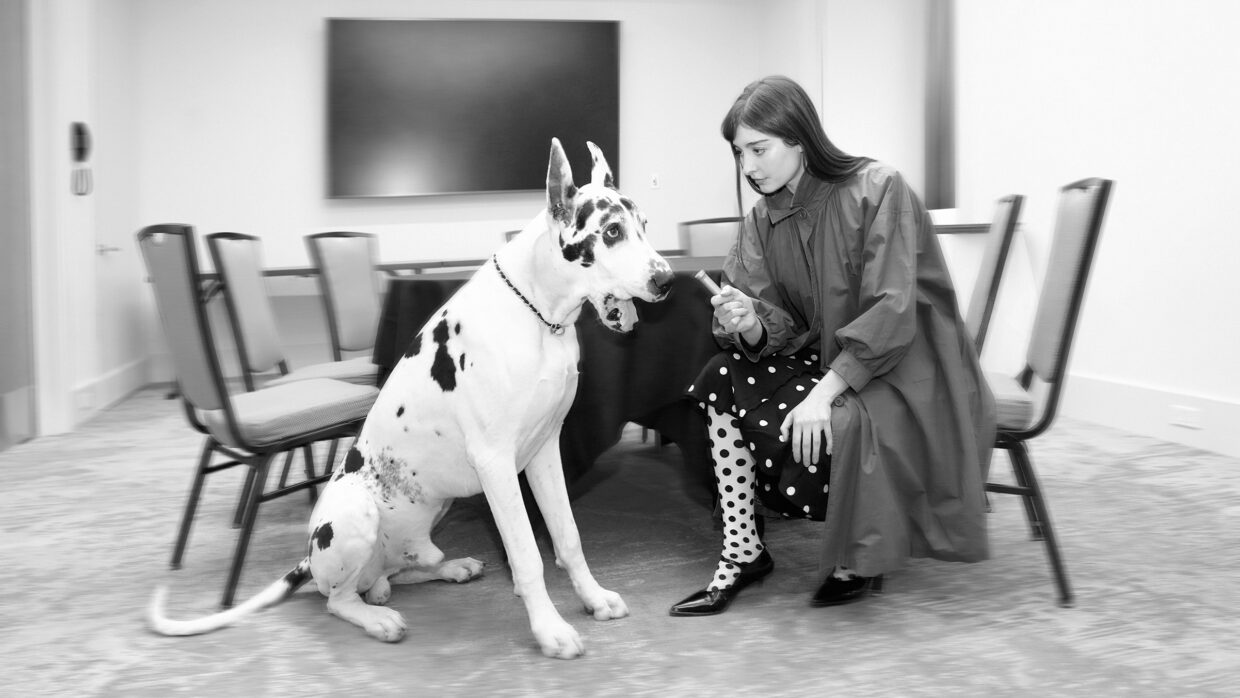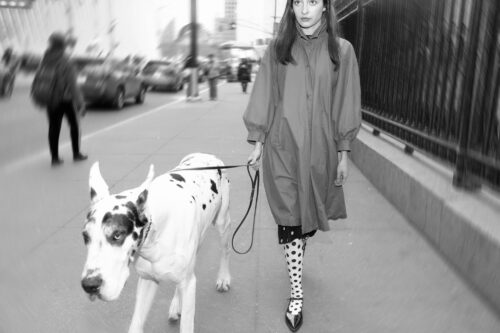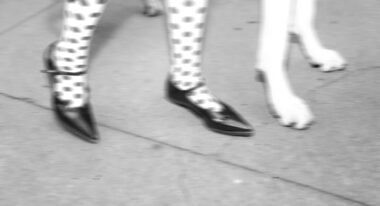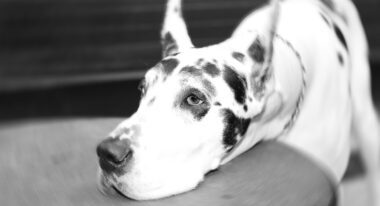 Back to selection
Back to selection
Amalia Meets Bing: Walking with the Canine Star of The Friend and Talking to Owner Bev Klingensmith and Trainer Bill Berloni
 Bing and Amalia Ulman (Photo: Amalia Ulman)
Bing and Amalia Ulman (Photo: Amalia Ulman) By mere chance, The Friend has been a part of my life for quite some time now. I was first introduced to the book when Hal Hartley recommended it for my book club sometime around 2021, when I was just a girl with two cats. Fast forward and it’s 2024, now I love dogs and had just adopted a puppy named Variety Magazine. It was during that spring, on one of those early days of puppyhood, that he got street cast for a b-roll sequence in an upcoming film… that was to be an adaptation of Sigrid Nuñez’s The Friend. I couldn’t believe it! I was especially touched by this because he is a quarter Great Dane, just like the dog in the book. The stage mom in me impatiently waited for a year to know if Variety had made it into the final cut… because if he ended up on the cutting room floor we would have to rehome him. (I’m joking, of course.) But I’m happy to report that he’s in it, alongside the magnificent Bing, Naomi Watts and Bill Murray.

Last week, I was lucky enough for Bing to find some time for me in his very busy schedule. I picked him up at his hotel in downtown New York and went on a little walk around the Financial District. I gave him some chicken hearts, and I saw him do some tricks. Then he took me to the hotel conference room so I could speak to his owner Bev Klingensmith and animal training superstar Bill Berloni.
Ulman: How did you meet Bing?
Klingensmith: I’m actually his breeder too. So, yeah, he was born in my home. He’s my fourth generation.
Ulman: And since you’re a breeder, I assume you sell a lot of the dogs you breed, right? How did you choose to keep him?
Klingensmith: When they are, like, eight weeks old, we have an evaluation process that involves structural things, mostly. I was very glad he was the pick of that litter, because I already kind of had a little bit of a bond with him, which is hard as a breeder — you have to make the decision to keep the nicest puppy in the litter, but [Bing] was both the nicest puppy in the litter and the one I wanted to keep. So, it was perfect.

Ulman: You are clearly familiar with breeding and training, but have you ever worked on a film?
Klingensmith: I have a normal nine-to-five job. I work in financial technology, but I volunteer at an obedience club, and I teach obedience classes. [Bing] started training super early, when he was around eight weeks old. Bing is an AKC [American Kennel Club] champion, so he has some obedience titles and other things as well. But I never worked on a film of this scale. Bing’s grandma and great grandma did some local commercials in Iowa. But nothing this big.
Ulman: And what style of training do you do with him? Clickers?
Klingensmith: We use treats and praise. Danes are a very sensitive breed, so you have to be firm, but if you’re too harsh with them, they just shut down. They don’t enjoy it, and they won’t really work as well. So, you have to keep it really fun for the dog, and, yes, he enjoys working. So, he’s been a real joy to train. (looking at Bing) You always make me look really good, don’t you, buddy.

Ulman: So how was it working on set?
Klingensmith: It was a lot of fun. It was interesting to see the behind the scenes. And he really enjoyed it. He got to go to work with me every day. The days he seemed to enjoy the most were the days he had very active behaviors. There was a lot of “stay” or walk on a leash. But when he had more active behaviors, he really enjoyed those, like when he had to scratch on the door. He likes figuring out what’s being requested of him.
Ulman: Was all the waiting around between takes hard for him? I know it is hard for human actors sometimes…
Klingensmith: The waiting around sometimes worked well, because dogs can only have so much time when they are actually focusing, like 20 or 30 minutes tops, so it was nice for him to take naps. Dogs sleep a lot normally. So, you have to balance it all and place the more complicated behaviors earlier in the schedule, when he was the most energized, and then something that was maybe easier for him, like just laying down or walking, for later. When we were in between takes, he would go take a nap, and he desperately needed those naps during those long days of shooting.
Ulman: What is his favorite thing to do?
Klingensmith: He loves puppies — he is enthralled with puppies.
Ulman: Has he fathered some?
Klingensmith: He has had a few litters — we’re very careful who we breed to. So, yes, he has, but he likes all puppies, not just his own.
Ulman: Oh, that’s so sweet. I noticed he always has his head on the ground, sniffing. He seems to be very good at it. Does he do a lot of scent training too?
Klingensmith: He does love to sniff, but it is because he is an intact male. But scent training isn’t really his strong suit. We just capitalize on the things that he enjoys more like obedience. We do something called Rally obedience. The typical AKC obedience is very structured. Rally obedience is a little bit more free form. Instead of the judge telling you what to do, they have placards on the ground that say, “Walk up to the station and do something, tell your dog to stand, tell your dog to lay down, turn, do something.” You can kind of have a running dialogue with your dog, so it’s a little bit more fun than traditional obedience. He is a really sweet, silly dog. A lot of people think that he’s a couch potato because he’s so subdued, but he’s not. Great Danes can be calm, but they also have energy needs, especially when they’re young. He’s a pretty energetic boy.
***
Ulman: I’m very excited to be talking to you. I’m a big fan of your work. Could you tell me how you got started?
Berloni: I’m from Connecticut, born and raised here, and when I graduated high school, I wanted to be an actor. There was a local theater that did professional productions, the Goodspeed Opera House. I wanted to be around professional actors and professional theater, so instead of spending my summers hanging out with my friends. I became an apprentice working backstage. In the summer of 1976 they were doing a new show that needed a dog, and they couldn’t afford a dog trainer. I was given the chance to be an actor in one of the shows if I would find and train a dog for free. And, so, I accepted that challenge, and that show was the original production of Annie. I went to the shelter and found the original Sandy for $7, adopted him, and a year later, the show opened on Broadway. And at the age of 20, I became a world-famous animal trainer. That was 47 years ago. I’ve had this blessed career with animals all this time, and I finally got to do the movie of my dreams.

Ulman: Yes! How was it to work on set with Bing?
Berloni: That’s a great story because Bing and Bev had never done anything like this. He was a sweet dog who knew how to heel and sit and stay and all the basic commands… but I had to turn him into a movie dog and Bev into a movie trainer in less than a month. And, so, it was a whole crash course in teaching Bev how to let someone else give commands, desensitizing Bing to the sounds and sights of the city, and then working with Naomi Watts and teaching her how to be a trainer. It was taking this raw clay and turning him into the star he is now.
Ulman: That was something that I had found interesting, that Bing had to play a city dog. Was he startled by Manhattan? Was it shocking to him?
Berloni: You could shock [any dog], but if you do it slowly, that’s how they learn to not be afraid of it. We were housed in Staten Island, so walking around the streets of Staten Island and down their main street, he started to get used to a more populous area, and then Naomi lives in the southern part of Manhattan, in an area that was quiet, so there wasn’t a lot of traffic or foot traffic. So, we started walking there. And then again, as [Bing] got more comfortable, [Bev] started bringing him to the more trafficky places. And after a week or two, he was fine with all of it.
Ulman: That’s great to hear. What sort of training do you use? I know that you’re improvised a lot since you started, sort of figuring out animals on a case-by-case basis and doing a lot of problem solving. But is there any school of training or other trainers you’re a fan of?
Berloni: No, I figured it out by myself. Back in the 1970s animal training was much more harsh and negative — if the animal didn’t do what you wanted, they would be punished. I grew up as an only child on a farm, and my companions, my playmates, were animals, so I quickly learned at a young age that if you don’t understand them and what they like to do, they’re not going to play with you. So, when I got the opportunity to work with Sandy, it’s like, if he’s not happy, he’s not going to want to go on stage. So how do I make him feel safe and secure, make the things that he wants to do fun and so he knows there’s a reward. Working with canines is much easier than some other species, but I’ve taken that theory and applied it to other species — cats, birds, pigs, sheep, goats and horses. It’s getting to know their physiology, their behavior, and then creating a method to ask them to do certain behaviors for rewards that they would appreciate.
Ulman: I don’t want to throw any species under the bus, but was there any animal that specially harder to train?
Berloni: Oh, every animal outside of a canine is harder to train because most other species don’t have any reason to listen to man. Maybe horses. Probably the hardest is the cat. They are independent nocturnal hunters, so getting them to follow you around on a set is hard — you can’t train them to do that. You can find cats who think they’re dogs, who have atypical feline personalities, and those are the cats we train. There’s probably only about six of them on the East Coast that can do that work, and I represent one of them.
Ulman: There’s this woman, Samantha Martin, who has created this show called The Amazing Acro-Cats, and the funniest thing about it is how the cats barely do the commands they are supposed to do. What has been your biggest revelation while training an animal? Have you ever had a breakthrough moment after struggling to train an animal for a while?
Berloni: That pretty much happens on every job that I work on, you know, because a human will write a script in which they’ll come up with animal behaviors based on their experience, on how that animal will tell the story. And often you get into the situation where, for example, there’s a person who is crying, and the dog’s supposed to go over and get a Kleenex box. You say “action,” and the dog believes the situation, believes that the person is actually crying, and does what a dog really would do. And most times what the animals do is better than what the people have written. On The Friend, we were constantly thinking of ways to make Bing look sad as a character. And one day, Bev and I were at the house, and the fire truck went by, and he started to howl, and it was a funny sound. And I said, “Wow, I wish he could do that.” And Bev went, “Oh, I can make him do it.” And she howled, and he sang right with her. Well, it was so fun that I decided to use it on set. Every time someone wrapped, as if to say, “I’m sad to see you go,” we had Bing howl. And once the directors saw that, they were like, “Wait a minute, we could put that in the movie.” That was one of those poignant moments that none of us had thought of, but Bing showed us he had that talent.
Ulman: Were you in Staten Island first only to desensitize him to Manhattan more gradually?
Berloni: When pre-production took place, it all happened very fast. When they finally got the green light. I think we had three months to prepare, and I said to them, “I need housing for three trainers and two large dogs and a big backyard,” and finding an Airbnb within commuting distance of New York City that could accommodate two Great Danes was difficult. The only house we could find was this little house on Staten Island that had a beautiful fenced backyard. It wasn’t the best accommodation, but it worked for us. It had a basement that we could rehearse in, but it was the backyard that I was most interested in, so the dogs could get out and run a little.
Ulman: Talking about New York City, I like your stories about hiding animals in rental apartments where they weren’t allowed to be. Like when you pretended a pig was a dog with a strange cough. So many people refuse to keep animals because of these restrictions and I always tell them, “If you wanted to, you would!”
Berloni: I mean, I won’t disclose my current apartment location, but yeah, I’ve had as many as eight dogs there, and I’ve got good neighbors. They don’t make any noise, and nobody complains. But, yeah, it’s, it’s New York City, and again, it’s a temporary lifestyle. We’re artists, and we just do what we have to do to make it happen.
Ulman: Who was your Holga? (An animal that changed your life and showed you the way to communicate to animals at large.)
Berloni: The very first dog I trained, the original Sandy. I had a dog growing up who was never on a leash — he was just by my side all the time. He slept in my bedroom. He was my best friend. Obviously we had some sort of bond and communication, but when I was actually given the task to ask an animal to do something, I really discovered that they communicate, they are sentient, and that you could actually communicate with another species, you know? I learned that I don’t need to go to Africa to see wild animals because I can look in the eyes of my dog or my cat and see another whole species who inhabits this earth. And the things they do, to me, are wondrous. And, so, it was the very first Sandy who taught me that.
Ulman: I love that. Is there anything that, whenever you do interviews like this that nobody has ever asked you but you wish you were asked?
Berloni: Yes. If I’ve ever won an Academy Award, because the answer is no. There’s no award for animal trainers and animals and their performances.
Ulman: And there should be!
Berloni: And there should be. You know, it’s amazing to me when you read the reviews of The Friend, they say how brilliant an actor Bing is. Well, Bing is not an actor. He’s doing everything I am telling him to do. He’s a good listener. And it happens to be filmed, but he himself is not the actor. I wish at some point there’d be a union for animal trainers, or an award for animal trainers, because I do believe our contribution is as important as anybody else’s on set.
Ulman: Of course, animals are a very important part of Hollywood history! Thank you so much for chatting with me and I hope you get a very much deserved Academy Award once they add the Animal Training category.
(Photographs by Amalia Ulman)
